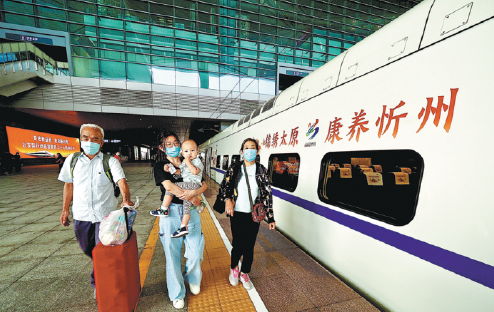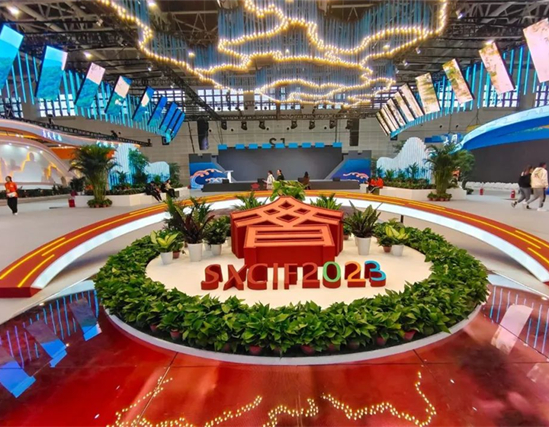Bullet train latest step to create a city cluster
Updated: 2022-08-12

Passengers are ready to board an intercity train from Taiyuan to Xinzhou. [Photo by Zhang Jiong for China Daily]
Shanxi officials link up Taiyuan and Xinzhou in integration program
In the early morning of July 4, a bullet train departed Taiyuan South Railway Station and ran north for about 50 minutes to arrive in the city of Xinzhou.
It marked the latest addition to intercity trains between Taiyuan, the provincial capital of Shanxi, and Xinzhou.
To date, there are a total of 12 intercity bullet trains running round trips between the two cities, bringing them into a one-hour commuting circle.
The train service has greatly assisted in travel for residents in both cities. But its significance goes far beyond passenger transportation. It is also an important part of the Taiyuan-Xinzhou integration program, a recent move that aims to build a city cluster and a powerhouse for development in the center of Shanxi, according to local officials.
The urban integration program of the two cities was launched in 2021 by the Shanxi provincial government, according to the central government's requirements.
In March 2021, the State Council released a guideline for the 14th Five-Year Plan (2021-25), requiring Shanxi to foster a city cluster in its central region. The cluster is proposed to host industries relocated from the Beijing-Tianjin-Hebei region, where an integrated regional development plan is in place.
Grasping the historic opportunity, the Shanxi provincial government proposed promoting the development of Taiyuan-Xinzhou Integrated Economic Zone in the months that followed.
The zone officially opened on Dec 29, marked by the establishment of the Promotional Center for the Development of Taiyuan-Xinzhou Integrated Economic Zone.
In less than nine months, the fledgling development zone has reported impressive achievements.
On March 28, Taiyuan-Xinzhou Integrated Economic Zone held a groundbreaking ceremony for 183 key projects settling there.
The projects were funded by businesses from across the country and involved a combined investment of 103.8 billion yuan ($15.37 billion).
However, Xinzhou was not the first city to integrate with Taiyuan. An earlier development program had paired up Taiyuan and its southern neighbor Jinzhong.
The two cities are linked by the Shanxi Transformation and Comprehensive Reform Demonstration Zone, which is now the biggest integrated development zone in Shanxi.
Officially established in November 2016, the zone sitting between Taiyuan and Jinzhong consists of four national development zones, three provincial development zones and one university industrial park with a total planning area of 600 square kilometers.
Over the five years since its establishment, the demonstration zone has been the major test site for Shanxi's economic transformation. This features reducing reliance on coal-mining and other heavily resource-consuming industries and fostering emerging sectors as new drivers for Shanxi's development.
The demonstration zone is planning to foster four large industrial clusters-precise electronics, synthetic biology, photovoltaics and modern services-each with an annual output value of more than 100 billion yuan as well as other emerging industrial clusters each with an annual output value of 10 billion yuan. They include information technology, silicon carbide, sapphire substrate and other new materials. All these sectors are expected to form a modern, advanced industrial system in the zone, according to local officials.
Large investment projects settling in zone include operations funded by Shanghai-based Cathay Biotech, solar power equipment producer Jolywood and lithium battery producer Housheng, which are both based in Jiangsu province.
Shanxi Transformation and Comprehensive Reform Demonstration Zone is also a test site of the province's institutional reforms, which aim to create a better business environment for enterprises.
These reform initiatives include the delegation of power in business registration and approval, streamlining licensing systems, whole-process assistance for enterprises' operations and policies for easier market access.
From the demonstration zone, these practices have been promoted to other development zones, as well as the whole province. This has led to substantial improvements in the business environment and a boom in entrepreneurship.
On June 22, Shanxi's development zones and industrial parks held a joint event for the signing of agreements, groundbreaking ceremonies and operation of investment projects. The event, the second of its kind this year, saw the signing of 321 projects, 302 groundbreakings and the operation of 189 projects.
Since August 2020, Shanxi has hosted eight such events, attracting the attention of business circles across the country and from overseas.
In the province as a whole, the boom in entrepreneurship is demonstrated in the steady growth of business entities.
According to the Shanxi Market Regulation Bureau, the number of business entities there reached 3.58 million by the end of June, an increase of 21.47 percent from the same period of 2021. The number of newly registered business entities reached 560,800 in the first half of this year, up 133.91 percent year-on-year.
The Shanxi Transformation and Comprehensive Reform Demonstration Zone recently applied to national authorities for its status to be lifted to a free trade zone and a national new area. The aim is to play a more important role in leading Shanxi's high-quality development and high-level opening-up, according to local officials.
Yan Jie contributed to this story.



